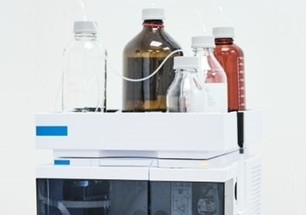Posted by Chrom Tech on 14th Oct 2025
Acetonitrile vs. Methanol for Reverse Phase Chromatography
Acetonitrile vs. Methanol in Reversed-Phase Chromatography
Acetonitrile (ACN) and Methanol (MeOH) are the two most common organic modifiers used in reversed-phase HPLC. Each solvent exhibits unique chemical and physical properties that influence retention, selectivity, pressure, and detector performance. This comparison explains their differences to help you choose the most effective solvent for your analytical workflow.
UV Absorbance and Optical Properties
Acetonitrile offers lower UV absorbance, lower viscosity, and superior miscibility with water—ideal for high-sensitivity UV detection and stable baselines. Both HPLC-grade and LC-MS-grade solvents are purified to remove UV-absorbing and ionic contaminants, but LC-MS-grade undergoes additional filtration to improve ionization efficiency and reduce background noise.
Acetonitrile Grades
- HPLC-Grade Acetonitrile: Low absorbance at short wavelengths for reliable UV quantification.
- LCMS-Grade Acetonitrile: Enhanced removal of metallic ions and particulates to ensure consistent MS sensitivity.
Methanol Grades
- HPLC-Grade Methanol: Suitable for general HPLC work but can introduce ghost peaks in gradient runs due to higher UV absorbance.
If baseline drift or ghost peaks occur, verify solvent grade and filtration. Use Chrom Tech sample preparation supplies and filtration tools to remove contaminants and ensure reproducibility when alternating between methanol and acetonitrile.
Column Pressure Differences
Methanol has a higher viscosity than acetonitrile, generating greater system backpressure at equivalent flow rates. Acetonitrile maintains lower pressure, extending column life and improving pump performance—especially important in high-throughput environments.
Elution Strength and Retention
Acetonitrile has stronger elution strength, producing shorter retention times and faster separations than methanol. For the same organic content, ACN delivers sharper peaks and shorter run times, making it the preferred solvent for high-throughput HPLC analysis.
Selectivity and Solvent Polarity
Methanol is a polar protic solvent capable of hydrogen bonding, while acetonitrile is polar aprotic with a strong dipole moment. These polarity differences directly influence analyte interactions and selectivity. Because both solvents are fully miscible, they can be blended to fine-tune selectivity for challenging separations.
Peak Shape and Separation Efficiency
Acetonitrile can occasionally cause peak tailing for acidic or phenolic compounds (e.g., salicylic acid), while methanol often improves tailing due to stronger hydrogen bonding with analytes and silica. On silica-based columns, acetonitrile typically provides sharper peaks; polymer-based phases show broader peaks, particularly in methanol systems.
Mobile Phase Degassing
Mixing methanol and water releases heat, aiding degassing and minimizing bubble formation. Conversely, acetonitrile absorbs heat and cools slightly during mixing, potentially creating bubbles and baseline noise if not properly equilibrated. Allow ACN-water mixtures to reach temperature equilibrium before use.
Comparison Table: Key Differences
| Property | Acetonitrile (ACN) | Methanol (MeOH) |
|---|---|---|
| Viscosity / Pressure | Low viscosity, low system pressure | Higher viscosity, increased backpressure |
| UV Absorbance | Low background absorbance | Higher absorbance at short wavelengths |
| Elution Strength | Stronger; shorter retention times | Weaker; longer retention times |
| Selectivity | Polar aprotic—less hydrogen bonding | Polar protic—hydrogen bonding interactions |
| Heat of Mixing | Absorbs heat (cooling) | Releases heat (warming) |
| Cost / Availability | More expensive; variable availability | Lower cost; widely available |
Availability and Cost
Acetonitrile is produced as a by-product of acrylonitrile manufacturing used in plastics. Market fluctuations can lead to temporary global shortages and price volatility. During shortages, many labs switch to methanol as a cost-effective alternative that maintains acceptable chromatographic performance.
Conclusion
Both acetonitrile and methanol are indispensable in reversed-phase chromatography. Acetonitrile delivers faster separations, lower backpressure, and cleaner baselines, while methanol offers affordability and tunable selectivity. The optimal choice depends on analytical goals—whether prioritizing speed, resolution, or cost efficiency. Always maintain consistent solvent purity, degas properly, and verify system compatibility when switching between organic modifiers.
Frequently Asked Questions
Which solvent provides better peak shape?
For phenolic or acidic compounds, methanol reduces tailing due to hydrogen bonding. For neutral or hydrophobic compounds, acetonitrile yields sharper, more symmetrical peaks.
Why is acetonitrile often preferred in HPLC?
Acetonitrile offers low viscosity, high elution strength, and excellent UV transparency—enabling faster runs, reduced pressure, and stable baselines.
When should I choose methanol?
Methanol is preferred when cost, safety, or availability are priorities. It can improve selectivity for polar or aromatic analytes that tail with acetonitrile.
Does methanol cause higher system pressure?
Yes. Methanol’s higher viscosity increases backpressure at identical flow rates. Reducing the flow rate can mitigate excessive pressure.
Can I mix acetonitrile and methanol?
Yes. Both solvents are fully miscible and can be blended to adjust selectivity, retention, and resolution based on compound polarity.
Which solvent is more UV-transparent?
Acetonitrile provides lower UV absorbance and cleaner baselines, making it ideal for UV and diode array detection systems.
Does solvent grade matter?
Absolutely. Use HPLC-grade or LC-MS-grade solvents to minimize impurities and ghost peaks. Lower grades risk UV contamination and inconsistent ionization.
Which solvent provides a more stable baseline?
Acetonitrile typically produces a smoother baseline due to lower absorbance and gas solubility, though proper degassing is still critical.
Is acetonitrile supply stable?
Availability can fluctuate because acetonitrile is a by-product of acrylonitrile production. During supply constraints, methanol serves as a reliable substitute.
Where can I buy high-purity chromatography solvents?
Visit Chrom Tech for LC-grade acetonitrile, methanol, and accessories designed for HPLC and LC-MS systems.

